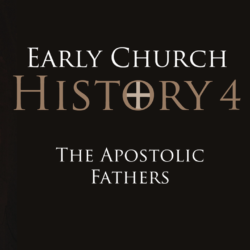This is part 13 of the Read the Bible For Yourself.
Before getting to the Church Epistles, we’ll begin with an overview of how letters were written, read, and performed. Then we’ll see how they are arranged in our Bibles. We’ll spend a good deal of time talking about occasion. Why did Paul write each letter? What was going on that prompted him to initiate the expensive and elaborate process of writing to them? Lastly, we’ll briefly consider how to apply what we read to our lives.
Listen to this episode on Spotify or Apple Podcasts
—— Links ——
- See other episodes in Read the Bible For Yourself
- Other classes are available here, including How We Got the Bible, which explores the manuscript transmission and translation of the Bible
- Get the transcript of this episode
- Support Restitutio by donating here
- Join our Restitutio Facebook Group and follow Sean Finnegan on Twitter @RestitutioSF
- Leave a voice message via SpeakPipe with questions or comments and we may play them out on the air
- Intro music: Good Vibes by MBB Attribution-ShareAlike 3.0 Unported (CC BY-SA 3.0) Free Download / Stream: Music promoted by Audio Library.
- Who is Sean Finnegan? Read his bio here
—— Notes ——
Letters in the First Century
- Letters written on papyrus with ink by a professional scribe (amanuensis)
- Though most letters that have survived from the ancient world were short and to the point, Paul’s Epistles are extremely long.
- Because there was no postal system, someone had to carry the letter to its destination.
- Upon arrival, most people couldn’t read, so a professional would need to read it aloud.
- This was difficult because there were no chapters, verses, paragraphs, punctuation, or spaces between words (scriptio continua).
|
Name |
Greek Words |
English Words |
Verses |
Chapters |
|
Romans |
7113 |
9506 |
432 |
16 |
|
1 Corinthians |
6832 |
9532 |
437 |
16 |
|
2 Corinthians |
4480 |
6160 |
257 |
13 |
|
Galatians |
2232 |
3227 |
149 |
6 |
|
Ephesians |
2424 |
3047 |
155 |
6 |
|
Philippians |
1631 |
2261 |
104 |
4 |
|
Colossians |
1583 |
1993 |
95 |
4 |
|
1 Thessalonians |
1484 |
1908 |
89 |
5 |
|
2 Thessalonians |
826 |
1065 |
47 |
3 |
Church Epistles in Chronological Order
- Galatians 48
- 1 Thessalonians 49-51
- 2 Thessalonians 49-51
- 1 Corinthians 53-55
- 2 Corinthians 53-55
- Romans 57
- Philippians 62
- Colossians 62
- Ephesians 62
Developing Your Knowledge of the Greco-Roman World
- Get background books like The World of the New Testament by Green and McDonald and Zondervan’s Illustrated Bible Background Commentary by Clinton Arnold.
- Read the literature that has survived. Hundreds of volumes are available in the Loeb Classical Library.
- Learn about archeology in the Mediterranean world around the time of Christ (Biblical Archeological Review).
- Take a tour to visit the sites in Greece and Turkey (Spirit and Truth International).
- Study the geography of the region on maps that show the correct place names for the first century.
Deciphering the Occasion
- Each letter arose out of a specific circumstance. What was going on among the Christians in that city that caused Paul to write?
- Galatians: Judaizers had visited churches Paul founded, telling people they needed to follow the law of Moses.
- 1 Corinthians: Chloe sent word of divisions in Corinth; Paul also received a letter asking specific questions.
- 2 Corinthians: false teachers had ensconced themselves in Corinth who criticized and undermined Paul.
- Philippians: Epaphroditus brought Paul financial assistance from Philippi.
Reading the Church Epistles
- The first time through, just get your bearings. Read for scope.
- What’s going on in that church? What’s going on in that city? What are their concerns? What are the doctrinal errors that Paul is correcting?
- The second time through, read more slowly, paying attention to major units of thought (usually paragraphs). Ask yourself how each section contributes to the whole.
- Sometimes it is difficult to understand a particular sentence or phrase.
- 1 Cor 15:29 “baptism on behalf of the dead”
- 1 Cor 11:10 “because of the angels”
- No one understands everything. It’s more important to get the main point than understand every little nuance.
Form of ancient letters[1]
- Author(s)
- Recipient(s)
- Greeting
- Prayer/thanksgiving
- Content
- Final greeting(s) and farewell
Content Section
- These Epistles are loaded with theology and practical application.
- Not systematic theologies, neatly organized
- Rather, they move from topic to topic based on the need of the congregation, oftentimes based on a previous (now lost) letter or communication they made to Paul.
- Romans and Ephesians come closest to laying out a theological system.
Application
- What is Paul asking them to do?
- Are my particulars similar enough to say this instruction applies to me as well?
- How much of what he said is culturally conditioned?
- Can I derive a principle that applies in general today?
Review
- Sending long letters in the Roman world was expensive and difficult due to the cost of materials, the skill required to write, and the need to have someone carry and read your letter aloud to the recipients.
- Paul sent the Church Epistles to Christian churches living in major Greco-Roman cities.
- We know much about the culture, politics, and geography of these cities due to surviving literature, archeological discoveries, and the ability to travel to them.
- Deciphering the occasion for which Paul wrote is the single most beneficial piece of information to help you understand an Epistle’s overarching purpose.
- As you read through an Epistle for the first time, try to get the big picture. Then as you read through it again, try to figure out how each section relates to the whole.
- It’s ok not to understand a particular verse. It’s more important to understand the point Paul is making rather than the particulars.
- When applying the Epistles to your life, look for comparable circumstances and general principles.
[1] See Fee & Stuart, p. 59






